
Success Stories in Documentation
|
October 16, 2025
|
7 Simple SOP Template Strategies for Effective Documentation
Overview
You might be wondering how to create effective Standard Operating Procedures (SOPs) that really work for your team. Well, this article shares seven strategies that use simple templates to help you out. It emphasizes the importance of clarity, getting everyone involved, and keeping things updated regularly. These strategies are backed by real case studies and statistics, showing that well-defined SOPs can lead to better compliance, increased operational efficiency, and a knack for adapting to those ever-changing business needs. So, let’s dive into how you can make your SOPs shine!
Key Highlights:
- SowFlow simplifies SOP creation with an intuitive platform and a Chrome extension for easy documentation.
- 97% of companies face challenges in document management, highlighting the need for effective SOPs.
- Defining the purpose and scope of SOPs enhances clarity and aligns with organizational goals.
- Collecting accurate data from subject matter experts (SMEs) improves the effectiveness of SOPs.
- Choosing the right format for SOPs (step-by-step, flowcharts, checklists) enhances usability based on task complexity.
- Engaging stakeholders in SOP development increases compliance and ownership among users.
- Regular review and testing of SOPs ensure they remain relevant and effective for operational needs.
- Implementing SOPs requires strategic communication and training to boost adoption and compliance.
- Frequent updates to SOPs maintain compliance with industry standards and improve operational consistency.
- Analyzing usage metrics helps organizations assess the effectiveness of their SOPs and identify areas for improvement.
- Training end-users through hands-on sessions and ongoing support is crucial for successful SOP implementation.
Introduction
In today's business world, you might be wondering just how crucial it is to create and implement Standard Operating Procedures (SOPs) effectively. Well, let me tell you, it’s absolutely vital for your organization’s success! As companies like yours navigate the twists and turns of their operations, there’s a growing need for streamlined documentation tools—like SowFlow. This innovative platform not only makes the SOP creation process a breeze but also helps your team document workflows effortlessly, ensuring that all that essential information is right at your fingertips.
Now, here’s something to think about: a staggering number of organizations are grappling with effective documentation practices. So, how can you leverage tools like SowFlow to unlock better operational efficiency and compliance? From defining what SOPs are all about to engaging your stakeholders and diving into usage metrics, this article is here to guide you through the key steps your organization can take. By fostering a culture of effective documentation, you can pave the way for success!
SowFlow: Instant SOP Creation for Streamlined Documentation
You might be wondering how a simple sop template can make the creation of Standard Operating Procedures (SOPs) easier and more effective. Well, SowFlow has got you covered! With its intuitive platform, you can instantly document everything your team does. Thanks to an easy-to-use Chrome extension, documenting workflows right from your browser is a breeze. This means you can record activities accurately and efficiently, saving you precious time while enhancing the quality of your documentation.
As we look ahead to 2025, the spotlight on documentation technology is only getting brighter. Businesses are waking up to the fact that solid documentation practices can unlock new levels of efficiency and success. Did you know that a staggering 97% of companies struggle with document management? This lack of organization can really hurt their competitive edge. But don't worry! By adopting SowFlow's solutions, you can bridge that gap and keep your documentation fresh and relevant in today’s fast-paced business world.
Speaking of benefits, let’s talk about can do for you. As Kate Apking puts it, "A lean entity concentrates all of its resources on delivering greater value for the customer." By improving knowledge management and reducing chaos, organizations can create a more structured operational framework. And guess what? Over 8,500 individuals have already signed up for expert advice on unlocking growth through effective documentation. Clearly, the demand for a simple sop template for efficient SOP creation is increasing!
So, how can you get in on this? By using SowFlow's advanced tools, including that handy Chrome extension, your team can effectively implement a simple sop template. This not only boosts overall organizational efficiency but also sets you up for long-term success. If you want to stay ahead of the game, consider integrating these documentation practices into your workflows. It’s all about helping your team operate with clarity and purpose!
Define Purpose and Scope: Establishing Clear Objectives for Your SOP
Before you dive into drafting , it’s super important to clearly define its purpose and scope. You might be wondering what that really means. Well, it’s all about clearly stating what the SOP aims to achieve and the processes it will cover. By setting these boundaries, you ensure that the simple SOP template remains relevant and focused, making it easier for everyone to understand and follow. A well-defined purpose not only boosts clarity but also aligns the simple SOP template with your organization’s goals, making it a key player in maintaining operational consistency.
Organizations that take the time to define the purpose and scope of their simple SOP template often see big improvements in compliance and efficiency. For instance, SowFlow’s solution lets teams share their documented workflows in just seconds, giving everyone quick access to the right procedures whenever they need them. This really shows how having clear objectives can directly impact how well teams implement their simple SOP template in their day-to-day tasks. Plus, research shows that when these procedures are crafted with a clear purpose using a simple SOP template, employees are much more likely to embrace them.
Just look at Forensic Analytical Consulting Services—they faced challenges with complex procedures that employees often avoided. By reorganizing their procedures to be more user-friendly, they not only boosted team efficiency but also fostered a culture where employees actively sought out SOPs for guidance.
As Joseph Williams and Joseph Bizup point out, using an active voice in instructional writing enhances clarity and accountability, which in turn ramps up the effectiveness of SOPs. So, in a nutshell, defining the purpose and scope of your simple SOP template is crucial for any organization wanting to improve operational control while expanding their systems. By setting clear objectives and using tools like SowFlow for instant access to documentation, businesses can make sure their SOPs are effective tools for consistency and compliance across all departments.
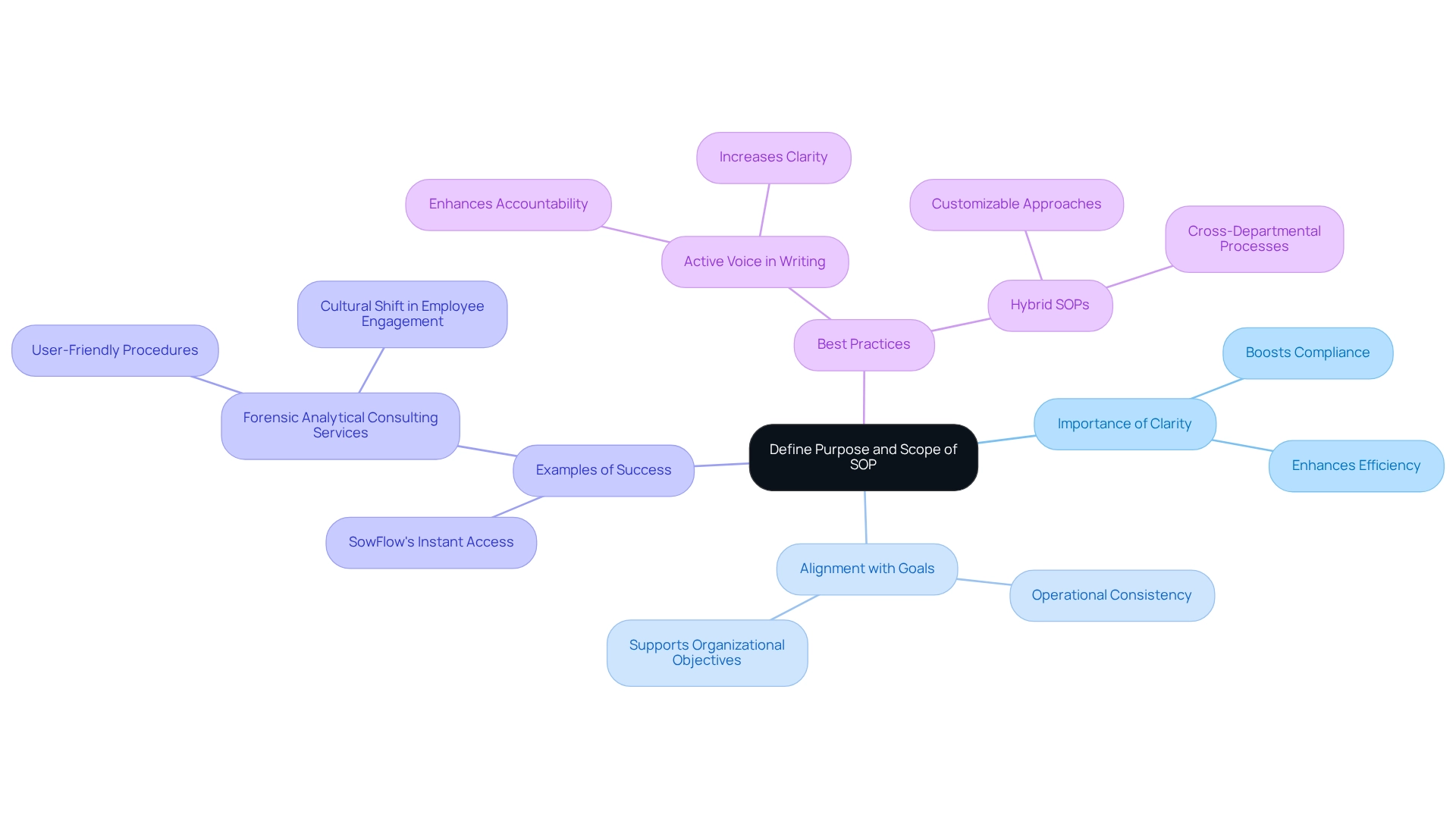
Gather Information: Collecting Essential Data for Your SOP
Collecting the right information is super important when developing your SOPs. You might be wondering how to go about this, right? Well, it involves chatting with subject matter experts (SMEs), diving into existing documentation, and even watching processes in action. By gathering a ton of data, organizations can make sure their standard operating procedures truly reflect the actual practices and needs of the tasks at hand. Plus, involving SMEs not only boosts the accuracy of these procedures but also builds trust among users who rely on these documents for guidance.
So, what are some best practices for gathering that all-important information? First off, defining the scope of your SOP can really help in pinpointing the right SMEs to consult. Effective data collection methods, like interviews and surveys, can provide valuable insights into the nitty-gritty of specific processes. And don’t forget about using tools that track metrics—like views and user feedback, as highlighted by Document360's analytics. These can help guide continuous improvements to your procedures, ensuring they stay relevant and effective.
Now, speaking of tools, even though you can rely on standard ones like Google Docs or a collection of Microsoft Word documents stashed in a central shared location, having a structured approach to creating your SOP is key. Case studies show that following structured methods, like those outlined in , leads to well-organized and implementable documents. This organized approach not only boosts operational efficiency but also ensures that your simple sop template remains relevant and up-to-date, adapting to the swift changes within organizations. By focusing on thorough data gathering and expert advice, companies can craft SOPs that genuinely meet their operational needs.
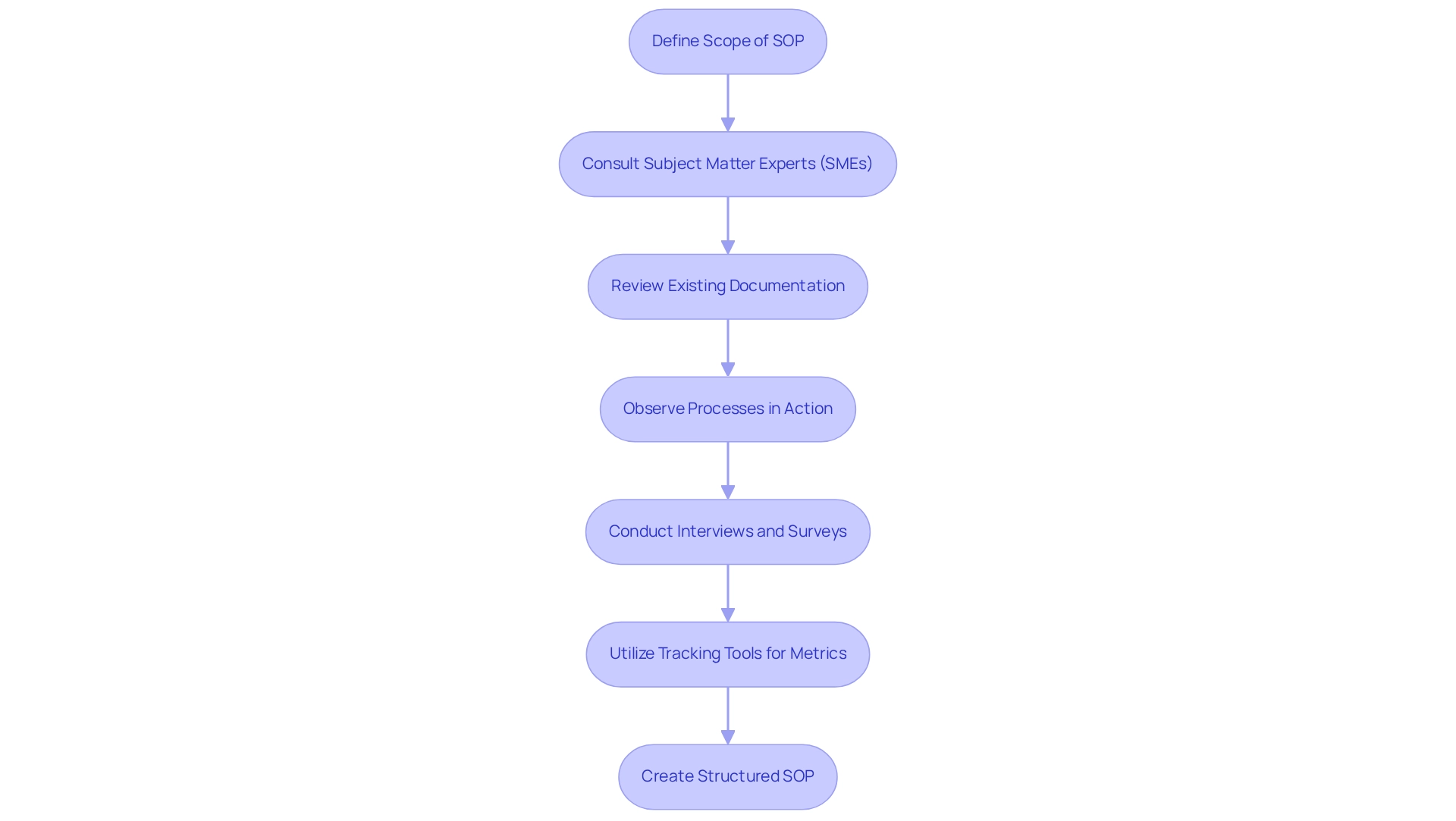
Choose Format: Selecting the Best Structure for Your SOP
Choosing for your Standard Operating Procedures (SOPs) is super important if you want to make them really effective. You might be wondering what formats are out there. Well, common options include:
- Step-by-step instructions
- Flowcharts
- Checklists
Each of these serves a different purpose based on how complex the task is and what the users prefer. For example, flowcharts are fantastic for processes that have a lot of decision points. They help users visualize the workflow clearly. On the other hand, checklists are perfect for simpler tasks, providing an easy way to make sure all steps are completed.
Once you’ve pinpointed the procedure that needs documentation, the next step is gathering the essential info to create a solid SOP. Research shows that a well-structured SOP usually includes:
- Title page
- Table of contents
- Purpose
- Scope
- Responsibilities
- Procedures
- References
- Revision history
This comprehensive structure not only boosts clarity but also improves compliance and usability.
Now, let’s talk about user preferences. They play a huge role in figuring out the best format. Engaging with end-users while developing the SOP can give you valuable insights into what they need. This way, you can ensure that the chosen format fits seamlessly into their workflow. A case study with Opus Epilogue Systems found that using digital tools in SOPs made training more efficient and compliant, which ultimately reduced errors.
By adopting effective documentation methods and utilizing tools and automation, businesses can reach new levels of efficiency and success. In summary, selecting the right format for your SOPs, such as a simple sop template, step-by-step guides, flowcharts, or checklists, should be a strategic choice based on the task's complexity and the users' preferences. This approach not only enhances the usability of your SOPs but also helps create a more organized and efficient operational environment.
Involve Stakeholders: Engaging Key Participants in SOP Development
Engaging key stakeholders in the SOP development process is crucial for crafting documents that are both practical and effective. You might be wondering why this matters. Well, involving team members who will actually use the SOP, along with managers and subject matter experts, ensures that the document tackles real-world challenges and incorporates best practices. This collaborative approach not only enhances the quality of the SOP but also fosters a sense of ownership among users, which, let’s be honest, increases compliance rates.
Statistics reveal that can lead to a 20% boost in profits. That’s significant, right? It underscores the importance of collaboration in SOP creation. By actively seeking feedback from diverse stakeholders, entities can enhance their documentation approaches, ultimately resulting in a more relevant and practical simple sop template. As Anastasia Masadi, a Product Owner, puts it, "SowFlow has been a game changer in the way we document work and deliver to our clients. I do not have to take each screenshot separately, and do not even have to leave the browser while I am creating SOPs and training materials. SowFlow gave me time from my life back."
Speaking of engagement, case studies show that assessing engagement metrics can help entities refine their strategies, resulting in better investment choices and overall project success. So, how can you effectively involve team members in SOP creation? Start by:
- Gathering necessary information from reliable sources
- Conducting interviews with subject matter experts
- Reviewing existing documentation before drafting the SOP
This comprehensive method not only boosts the SOP's efficiency but also ensures it aligns with the entity's evolving needs. Plus, clearly defining the scope of the SOP from the get-go helps prevent scope creep, keeping the document focused and manageable.

Review and Test: Validating Your SOP for Effectiveness
After drafting an SOP, you might be wondering how to make sure it really works. Well, the first step is to review and test it! This often kicks off with a pilot test involving a small group of users. It’s a great way to gather valuable feedback on how clear and usable the document is. During this phase, it’s super important to spot any gaps in information or steps that aren’t crystal clear. By tackling these issues before rolling out fully, you not only enhance the reliability of your standard operating procedures but also ensure they function effectively as intended.
Now, let’s discuss best practices for reviewing and testing those SOPs. Obtaining formal approval through a simple SOP template from the right stakeholders before implementation is key. It helps align the document with your organization’s goals, making sure all necessary perspectives are considered, which enhances the SOP's effectiveness. And don’t forget to instruct your staff on how to get the latest versions of the SOPs! Outdated copies should be clearly marked as 'obsolete' to avoid any mix-ups.
Did you know that regularly evaluating and updating your SOPs can significantly improve their relevance and effectiveness? For instance, keeping a Revision History helps you track changes, previous editions, and the reasons for updates. This way, your SOPs stay current and efficient. Plus, by using SowFlow’s instant guide creation and user-friendly tools, you can streamline the review process, making it easier to adapt your SOPs to changing business needs. A case study on the level of detail in SOPs shows that matching the complexity of the task with the right level of detail really boosts usability and cuts down on errors. By implementing these strategies, you can ensure your SOPs are not just clear and actionable but also flexible enough to adapt to evolving business requirements. Want to learn more about how SowFlow can help you enhance your SOPs? Contact us today!
Implement SOP: Strategies for Successful Adoption Across Teams
You might be wondering how to effectively implement a simple SOP template for . Well, organizations need to take a strategic approach that highlights the purpose and benefits of the simple SOP template to all team members. It's super important that everyone understands why a simple SOP template matters; this understanding helps create a culture of compliance and efficiency. Have you thought about arranging training sessions? They can really help users get familiar with the procedures and see how they fit into everyday activities, which can boost adoption rates significantly.
Now, let’s talk about access. Offering easy access to these procedures—whether through a centralized digital platform or printed materials—makes it easier for employees to reference them when needed. Plus, incorporating a simple SOP template for regular follow-ups and feedback sessions is key to keeping these procedures relevant. They allow teams to tackle any challenges that pop up. And don’t forget about regular audits! These are vital for maintaining quality standards, ensuring that processes stay effective as technology and industry standards change. Statistics show that audits play a crucial role in sustaining quality. By encouraging continuous improvement, standard procedures help teams spot inefficiencies and areas for enhancement, leading to a more structured and scalable operational environment. As Edwin Korver wisely points out, effective leadership and communication are essential for fostering a culture that embraces these practices.
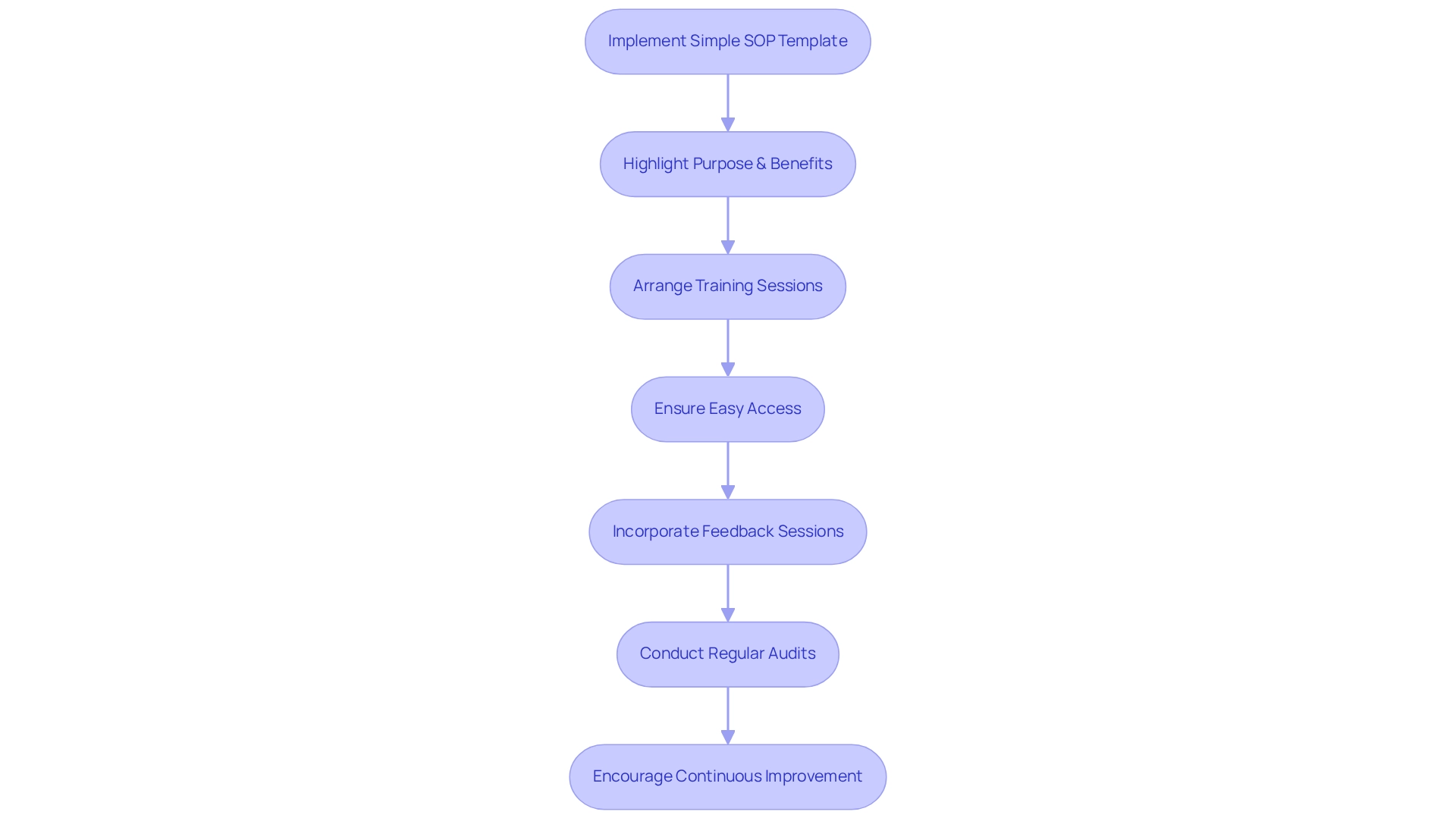
Update Regularly: Maintaining Relevance in Your SOP
You might be wondering how to keep your Standard Operating Procedures (SOPs) fresh and effective by utilizing a simple sop template. Well, one key step is to prioritize regular updates! Setting up a systematic review schedule—ideally every year or every six months—lets your team evaluate how relevant and accurate the SOPs really are. During these evaluations, it’s super important to think about any changes in methods, technology, or regulations that could affect how applicable the SOPs are. Plus, getting users involved in not only brings in valuable insights but also fosters a sense of ownership. This way, the SOP remains a practical tool for everyone involved.
Regular updates are crucial for staying compliant with industry standards and legal requirements, helping you dodge risks and avoid costly mistakes. And let’s not forget, 'Standard Operating Procedures also create a fair work environment.' When everyone follows the same guidelines and processes, it highlights the bigger picture—upholding SOPs goes beyond just operational efficiency. Organizations that regularly audit their SOPs often see improvements in quality control and operational consistency. This practice not only boosts the reliability of products and services but also supports continuous improvement as industry standards evolve.
Did you know that organizations that frequently refresh their SOPs enjoy better backup coverage for key positions? This makes transitions during employee onboarding and offboarding a lot smoother. By committing to a culture of regular reviews, you can significantly enhance the effectiveness of your simple sop template, ensuring it adapts to the ever-changing landscape of your operations. To make this happen, operations managers should think about setting specific dates for SOP reviews and involve team members in the process for comprehensive updates. Now, let’s dive into how you can implement these strategies effectively!
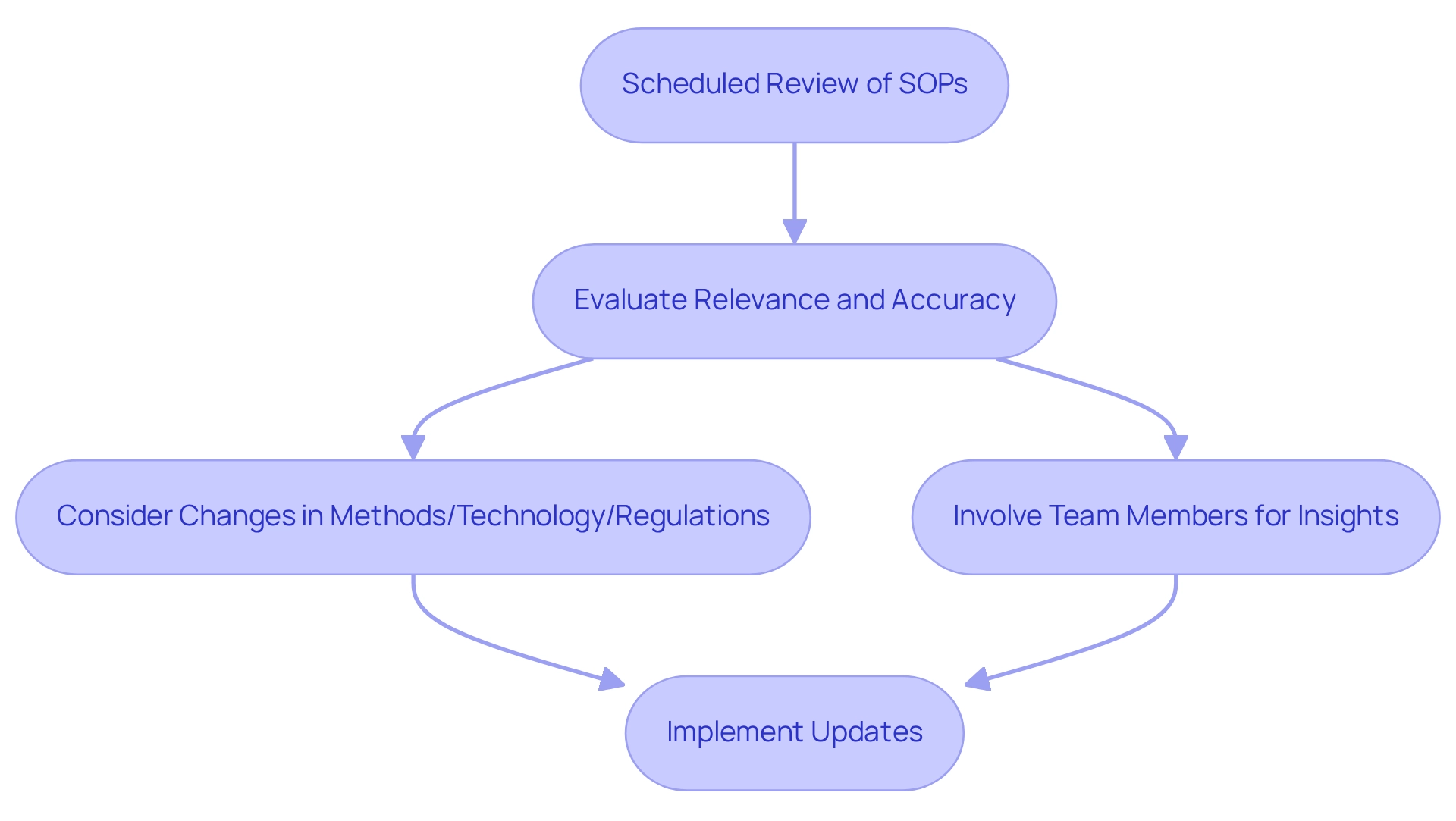
Analyze Usage Metrics: Measuring the Effectiveness of Your SOP
You might be wondering how to really measure the impact of your SOP. Well, it all boils down to analyzing usage metrics that show how well people are sticking to the procedures and how effective they really are. Key metrics to keep an eye on include:
- Compliance rates
- How often the SOP is used
- What users are saying about its clarity and usefulness
Did you know that research shows people spend about 60% to 80% of their time just looking for information? That really highlights how crucial it is to have clear and accessible procedures in place.
Now, let’s dive into something Hilary Mason once said: "the data alone cannot give you all the answers you’re looking for.” This really drives home the point that data analysis should go hand-in-hand with intuition and asking . By systematically gathering and reviewing this data, organizations can spot trends and identify areas that need a little TLC. This kind of analytical approach not only sharpens the SOP itself but also emphasizes its role in boosting operational efficiency. After all, when teams can work more effectively and with less confusion, everyone wins!
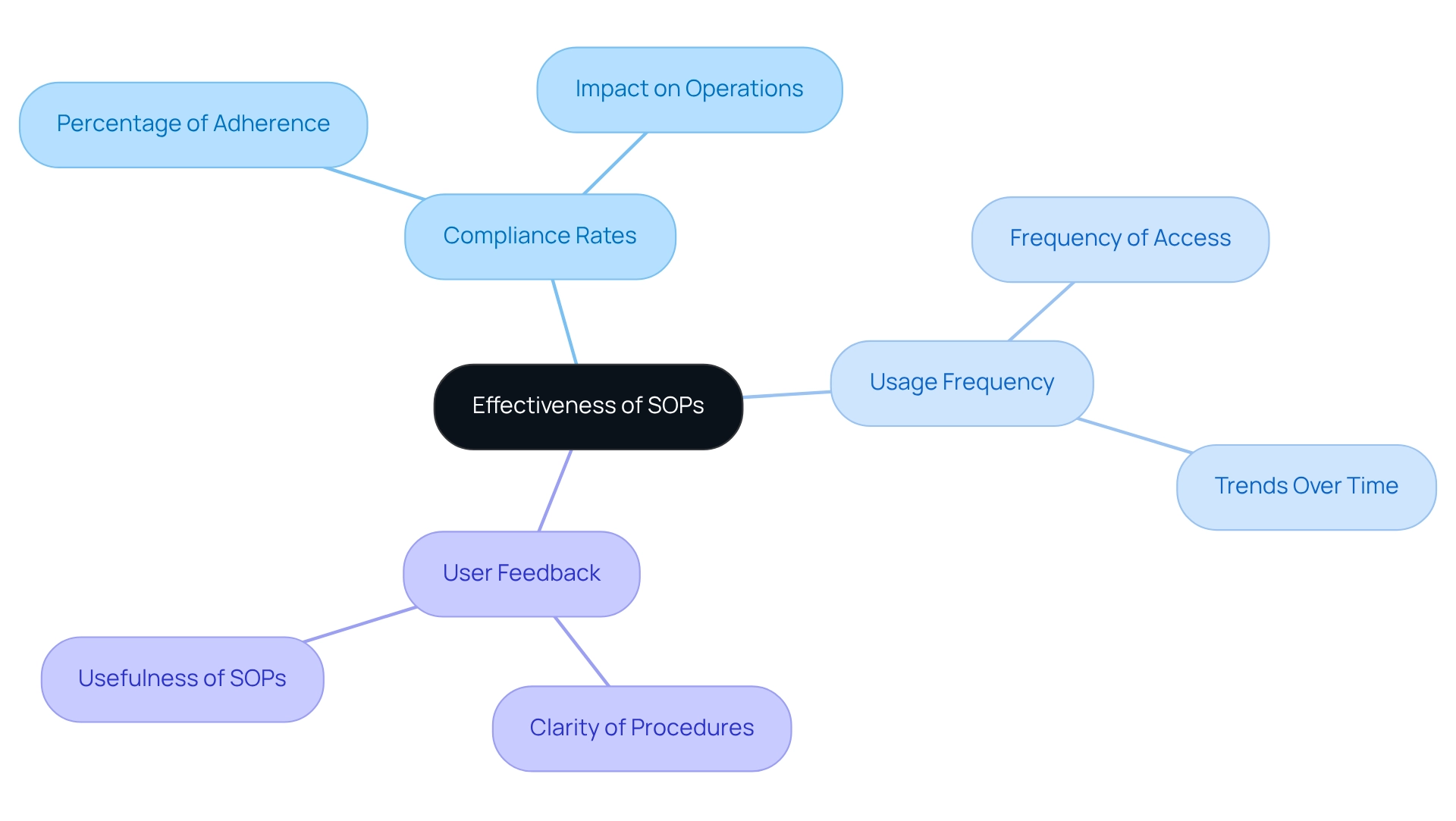
Train End-Users: Ensuring Effective Use of Your SOP
You know, training end-users on the simple SOP template is super important for ensuring everything runs smoothly and stays compliant. Organizations really should set up a solid training program that includes:
- Hands-on sessions
- Workshops
- Resources that are easy to access
With SowFlow's instant documentation solution, teams can share their workflows in just seconds, so users can grab the right documents right when they need them. This approach lets users get their hands dirty with the SOPs in a practical setting, boosting their confidence in following the documented procedures effectively.
Now, let’s not forget about continuous support and refresher courses. These are crucial for highlighting the importance of SOPs, helping users stay sharp and informed. Did you know that 46% of respondents feel that consistency is key to delivering ? That really shows why effective training is a must. Plus, the drop in organizations achieving full PCI compliance—from 43.4% in 2020 to just 14.3% in 2023—really highlights how vital proper training with a simple SOP template is for maintaining compliance and operational standards.
She emphasizes that weaving SOP training into actual workflows can really enhance how well information sticks and gets applied. By putting this training front and center in operations, companies can make sure their employees are well-prepared to tackle processes. Successful case studies, like the development of a simple SOP template for Cybersecurity, demonstrate how structured training can establish a solid foundation for managing risks and ensuring compliance. This training played a big role in the successful rollout of that SOP, proving just how essential hands-on training and ongoing support are.
By prioritizing interactive training and continuous support, along with SowFlow's instant access to documentation, organizations can really boost SOP adherence and overall operational efficiency.
Conclusion
Implementing Standard Operating Procedures (SOPs) is essential for enhancing operational efficiency and ensuring compliance within organizations. You might be wondering, what’s the best way to go about it? Throughout this article, we’ve highlighted key strategies that can make a real difference. For starters, defining the purpose and scope of SOPs is crucial. Gathering relevant information and choosing the right format can really enhance usability.
Engaging stakeholders in the development process is a game-changer. It fosters a sense of ownership and encourages adherence. Plus, thorough review and testing help ensure that SOPs remain effective and relevant. Now, let’s not forget about the importance of regular updates and analyzing usage metrics. These practices are vital for maintaining the effectiveness of SOPs, allowing organizations to adapt to changing processes and industry standards.
Training end-users effectively is equally important. It equips them with the knowledge and skills to confidently utilize SOPs in their daily operations. Speaking of that, have you ever thought about how innovative tools like SowFlow can streamline the SOP creation process? They make documentation accessible and efficient, which is a win-win!
By prioritizing these practices, organizations can not only improve compliance and operational consistency but also position themselves for sustained success in a competitive landscape. Embracing a culture of effective documentation isn’t just a best practice; it’s a strategic imperative that can unlock new levels of growth and efficiency. So, what are you waiting for? Let’s dive into the world of effective SOPs and see how they can transform your operations!
Frequently Asked Questions
How can a simple SOP template improve the creation of Standard Operating Procedures?
A simple SOP template can streamline the documentation process, making it easier and more effective for teams to record workflows accurately and efficiently, ultimately saving time and enhancing documentation quality.
What tools does SowFlow offer for documenting workflows?
SowFlow provides an intuitive platform and an easy-to-use Chrome extension that allows users to document workflows directly from their browser.
Why is documentation technology becoming increasingly important for businesses?
As of 2025, businesses recognize that solid documentation practices can significantly enhance efficiency and success, addressing the common struggle of 97% of companies with document management.
What are the benefits of streamlined documentation?
Streamlined documentation improves knowledge management, reduces chaos, and creates a structured operational framework, leading to greater value delivery for customers.
How can organizations effectively implement a simple SOP template?
Organizations can effectively implement a simple SOP template by using SowFlow's advanced tools, which help boost overall organizational efficiency and maintain clarity and purpose in operations.
What is the significance of defining the purpose and scope of an SOP?
Clearly defining the purpose and scope ensures that the SOP remains relevant and focused, aligns with organizational goals, and improves compliance and efficiency.
How can organizations gather the right information for developing SOPs?
Organizations can gather information by consulting subject matter experts (SMEs), reviewing existing documentation, and observing processes in action to ensure their SOPs reflect actual practices.
What best practices should be followed when collecting information for SOPs?
Best practices include defining the scope to identify the right SMEs, utilizing effective data collection methods like interviews and surveys, and using tools to track metrics and user feedback for continuous improvement.
Why is a structured approach important in creating SOPs?
A structured approach ensures that SOPs are well-organized, implementable, and adaptable to changes, enhancing operational efficiency and keeping documentation relevant and up-to-date.
👍
What others are liking
5 Steps to outline your ideal documentation structure
5 MINS READ
Where to start the your journey of mapping out your ideal documentation structure, aligning it with the very heartbeat of your organization?
Defining a winning level of detail in your process
3 MINS READ
What is too much detail, and what is too little? This article described in that winning level detail about what detail is enough.





